Nitto Group considers its response to nature-related issues as a critical management issue. Every year, we assess and review the impact on our business from our dependencies on and impacts on nature, as well as the associated risks and opportunities, and make revisions accordingly. In addition, we announced our support for the Taskforce on Nature-related Financial Disclosures (TNFD) and registered as a TNFD Adopter in August 2025. |
 |
The Nitto Group has set “Realizing a decarbonized society,” “Realizing a circular society,” and “Conserving biodiversity” as its material issues for sustainability and promotes initiatives to address environmental challenges, including those related to nature.
To resolve environmental issues including those related to nature, the Group is working to develop and promote short- to mid-term and long-term strategies by establishing a governance system where President-Director & CEO is appointed as the superintendent, and the Corporate Strategy Meeting plays the central role under the direction and supervision of the Board of Directors.
In addition, in order to increase the effectiveness of environmental initiatives including those related to nature, a Vice President has been appointed as the responsible officer. The Nitto Group’s governance structure is as follows:
The Nitto Group places environmental, social, and governance (ESG) at the core of its management. As such, rather than establishing a general sustainability committee or ESG committee, we use the Corporate Strategy Meeting, chaired by the President-Director & CEO and comprising of all Vice Presidents, as a platform to discuss the promotion of ESG management. This enables us to incorporate ESG into management in a swift and appropriate manner, and to achieve governance that ensures higher feasibility by integrating the company’s sustainability and growth strategy.
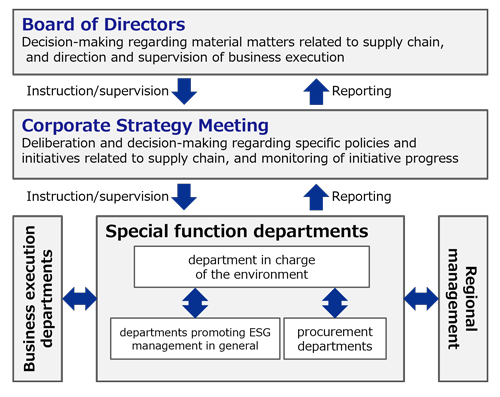 |
The Board of Directors makes decisions on important matters, for instance, management policies, management indicators and targets related to the environment including nature, such as the Mid-term Management Plan and support for external initiatives. Each quarter, it provides periodic directions and conducts supervision concerning targets related to environment (future-financial targets) in the Mid-term Management Plan as well as the status of progress toward target achievement, and, as necessary, adds new items to the agenda if a material matter arises.
The Board of Directors is comprised of Directors who possess qualifications, knowledge, and experience related to sustainability including nature, and who thus impart it with a sustainable and greater supervisory function. Please refer to the following for information on the skills of directors.
As for Director remuneration, ESG items (future-financial targets regarded as material issues) have been included in the criteria for performance linked share-based remuneration (additional remuneration as an incentive for improving medium-term performance). The number of shares to be granted ranges from 0% to 150%, depending on the progress made toward achieving the key performance indicators of consolidated operating income, consolidated ROE, and ESG-related items (future -financial targets laid out in the Mid-term Management Plan) at the end of the three-year period from the start of the performance evaluation period.
The Corporate Strategy Meeting, chaired by the President-Director and CEO, is responsible for deliberation and decision-making regarding specific policies and measures for action based on management policies and management indicators regarding the environment including nature. It also manages risks and opportunities across the value chain arising from dependencies and impacts and monitors progress towards achieving targets on a monthly basis. It provides periodic reports on a quarterly basis to the Board of Directors on its deliberations and decisions and the progress of initiatives, and, as necessary, provides additional reports if a material matter arises. Additionally, to ensure that the matters deliberated and decided are promptly disseminated throughout the company, the Corporate Strategy Meeting comprises all Vice Presidents who are in charge of business execution departments, special function departments, and regional management.
*Business execution departments... The Nitto Group has established divisions by product, and each division formulates comprehensive domestic and overseas strategies for the products it handles and carries out business activities accordingly. The departments belonging to each business division are defined as Business execution departments.
*Special function departments: The Nitto Group defines departments that handle specialized tasks such as human resources, accounting, safety, and environment as Special function departments.
We have appointed a Vice President in charge of promoting environmental initiatives including nature, and also have a special function department responsible for implementing those initiatives that serves as the department in charge of the environment. The department regularly assesses dependencies and impacts as well as risks and opportunities on nature, considers strategies, and executes and promotes measures to tackle nature-related issues. The Vice President manages and supervises the results of these assessments, the details of their consideration, and their implementation and promotion. In addition, the progress of these initiatives is periodically reported to the Corporate Strategy Meeting primarily by the department in charge of the environment.
The Group identifies the dependencies and impacts on nature, and appropriately manages nature-related key risks and opportunities that management recognizes may significantly impact its business activities. Additonally, we implement comprehensive management across the Group by combining them with other key risks that also significantly impact our business activities.
We assess and identify the importance of business dependencies and impacts on nature, as well as related risks and opportunities in our business activities, and determine priorities. The LEAP approach is used for assessment and identification. Details on the process is as follows: Also, the current assessment scope is limited to the Nitto Group’s manufacturing sites and the upstream portion of the value chain for certain products that are considered to have relatively high dependence or impact on nature.
1. Identification of priority locations (Locate)
Regarding manufacturing sites, we identified sensitive locations from the perspectives of “Biodiversity importance,” “Ecosystems integrity,” “Importance of ecosystem service,” as well as “Water stress and drought risk” and “Impact on indigenous peoples.” We designated sites strongly connected to nature or local communities as material locations. Areas where sensitive locations and material locations overlap are particularly identified as key priority locations (described later as priority locations). (Tools used: Aqueduct, iBAT, and Global Forest Watch)
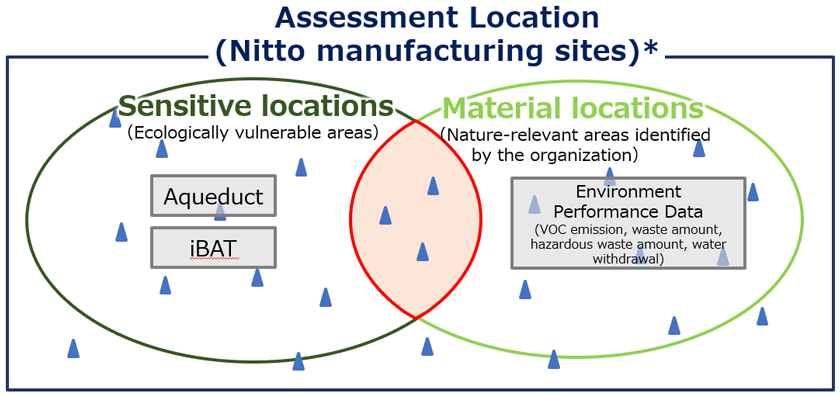 *The Nitto Group considers manufacturing sites to be the main sources of environmental impact, and therefore focuses on those sites. |
2. Evaluation and identification of dependencies and impacts (Evaluate)
We investigated the activities of our manufacturing sites located in priority locations, assessed our dependencies and impact on nature using actual environmental performance data, and conducted a relative evaluation based on the “extent” of these dependencies and impacts as well as their “ likelihood of occurrence” in priority locations to identify the dependencies and impacts relevant to our company.(Tools used: LIME3)
- LIME3: Globally applicable environmental impact assessment methodologies across the life cycles of products and organizations.
3. Assessment and identification of risks and opportunities (Assess)
Regarding the risks and opportunities assumed to arise from the identified dependencies and impacts, we assess and identify their relative importance by understanding how changes in the internal and external environment will affect our company, assessing the “degree of impact” on business if such events occur, and the “likelihood of occurrence,” while also determining the priority of these risks and opportunities. Additionally, when identifying risks and opportunities, we utilize scenario analysis to understand those related to the environment, including nature, and assess their potential financial impacts.
We evaluated (using LIME3 calculated from the LIME3 Integration Factor in IDEA v3.3) and selected raw materials assumed to have a significant impact on nature for certain products. We identified sensitive locations for major suppliers’ manufacturing sites of the selected raw materials from the perspectives of the “Biodiversity importance,” “Ecosystems integrity,” “ Importance of ecosystem service,” as well as “Water stress and drought risk.” (Tools used: Aqueduct, iBAT, and Global Forest Watch)
We understand the impact on our company regarding the dependencies on and impacts over nature, as well as related general risks and opportunities, at the manufacturing sites of suppliers located in sensitive locations. We will have our initiatives on engaging with our suppliers on nature-related issues, working to identify material locations, assess and identify supplier-specific dependencies on and impacts on nature, and strive to understand, evaluate, and identify the associated risks and opportunities for our company. In addition, the main risks and opportunities identified in addressing climate change issues (TCFD) are also managed as environment-related risks and opportunities, including those related to nature.
The Nitto Group appropriately manages the key risks and opportunities related to the environment, including selected aspects of nature, within the following risk management promotion framework.
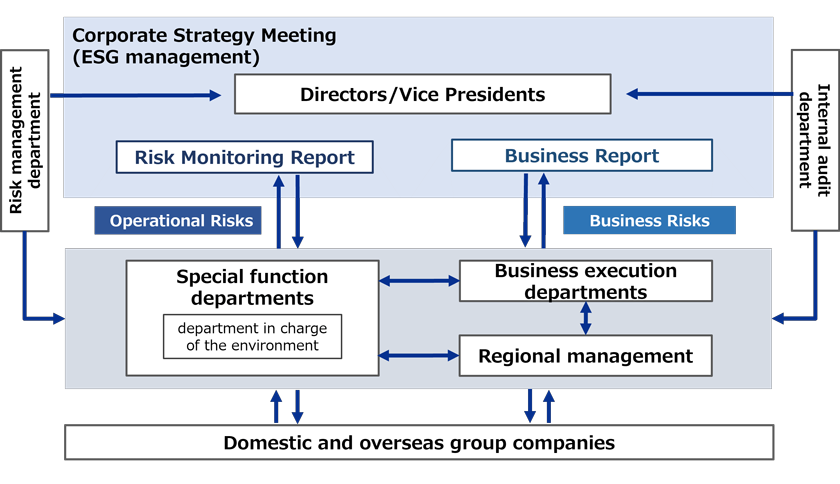 |
Risks and opportunities related to the environment, including nature, are monitored through collaboration between Business execution departments and Regional management, with the department in charge of the environment bearing overall management responsibility. Information regarding monitored risks and opportunities is reported and discussed every month at the Corporate Strategy Meeting, which consists of directors and executive officers, together with other information managed by specialized departments. The results of the deliberations are immediately communicated to the relevant departments, measures against risks and opportunities are promptly implemented, and efforts are made to strengthen controls. Details on implementation and status on improvement are reported and reviewed once again at the Corporate Strategy Meeting, thereby enhancing the effectiveness of the Group’s management.
In addition, major environmental risks and opportunities, including those related to nature, that have been reported to or discussed in the Corporate Strategy Meeting are self-assessed by the environmental department responsible for management, based on evaluation criteria such as the establishment of an implementation system, execution of controls and countermeasures, and the occurrences of and response to incidents at the end of the fiscal year. The risk management department will independently assess these matters, obtain approval from the officer responsible for risk management, and report it as an independent assessment to the Corporate Strategy Meeting and the Board of Directors.
Risks and opportunities related to the environment, including nature, are managed comprehensively across the group by integrating them with other key risks that have a significant impact on business activities. We conduct a two-axis analysis with the “degree of impact” on the business if a risk actually occurs or becomes apparent on the vertical axis, and the likelihood of occurrence” on the horizontal axis, thereby evaluating each risk in relative terms and recognizing the importance of nature-related risks among company-wide risks. In addition, these company-wide risks are broadly classified into “business risks” related to business operations and “operational risks” that impact the entire group, and appropriate risk management is conducted for the entire group. The main risks for the entire group in fiscal year 2024 are as follows. For more details, please refer to the link below.
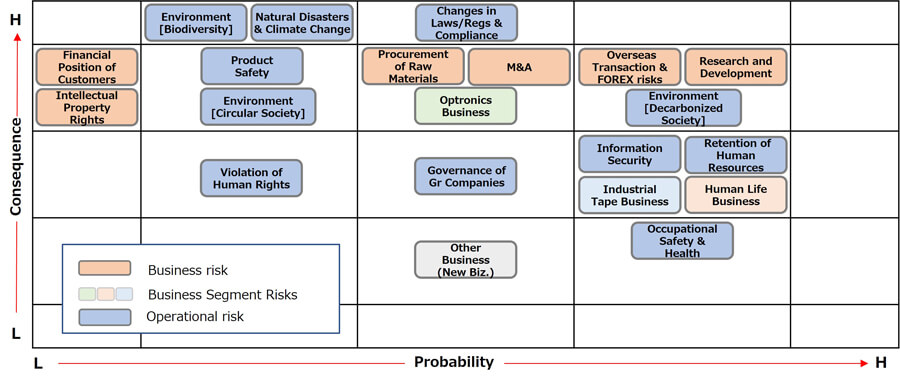 |
The Nitto Group aims to achieve nature positivity by not only understanding the impacts on its business from major environmental risks and opportunities, including those related to nature, but also by identifying and taking measures to address its own dependencies and impacts on nature through its business activities. In addition, we recognize “Realizing a decarbonized society,” “Realizing circular society,” and “Conserving biodiversity” as key management issues and are strategically incorporating them into our management practices.
We are developing scenarios that envision the potential states of the world related to “ecosystem services,” which are closely linked to physical risks affecting business activities, and “policies, legal regulations, or industry and market needs,” which are closely associated with transition risks.
Looking ahead to 2050, we are considering the situations shown in the diagram below: one where there is a high priority on nature (with growing trends in policies, regulations, or industry and market needs) and where the degradation of ecosystem services is minimized, and another where there is a low priority on nature (with little to no change, or even a decline, in such trends) and where the degradation of ecosystem services is significant.
Furthermore, we believe that a situation where the degradation of ecosystem services is minimized closely resembles the 1.5°C scenario for climate change, as this situation stems from significantly reduced greenhouse gas emissions, leading to a slower progression of climate change and reduced impact on nature. On the other hand, when there is significant degradation of ecosystem services, we consider it to closely resemble the 4°C climate change scenario, as this situation both results from a lack of reduction in greenhouse gas emissions and the intensification of abnormal weather and natural disasters, thus leading to more serious impacts on nature.
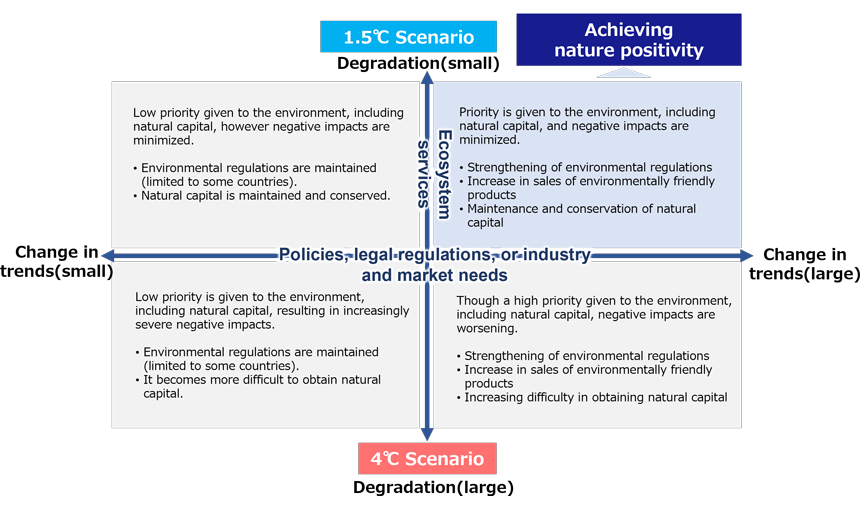 |
We have identified potential dependencies and impacts on nature at Nitto Group’s manufacturing sites in priority locations.
| Expected changes in nature | |||||||
|---|---|---|---|---|---|---|---|
| Occurrence and intensification of natural disasters | Degradation of ecosystems | Changes in the living environment of local residents | Sea level rise | Decline in soil and water purification functions | Salinization of groundwater | ||
| Dependence | Land use | very low | |||||
| Water resource utilization (groundwater and surface water) | medium | medium | very low | ||||
| Impact | GHG emissions | medium | low | low | low | ||
| Air pollution | low | low | |||||
| Water pollution | low | low | |||||
| Soil pollution | very low | very low | |||||
| Noise and light pollution | very low | ||||||
| Waste emission (landfill/incineration) | medium | ||||||
The degree of dependence and impact of each item is relatively compared as very high, high, medium, low, very low.
Blank fields are considered to represent items with extremely low levels of dependency or impact.
In business activities, potential dependencies and impacts related to water resource utilization, GHG emissions, air pollution, water pollution, soil pollution, noise and light pollution, and waste emissions (landfill/incineration) have been identified. Among these, it was suggested that there is a certain degree of dependence and impact on factors such as “ecosystem degradation” and “decline in water purification functions” due to water resource utilization, “occurrence and intensification of natural disasters” due to GHG emissions, and “changes in the living environment of local residents” due to waste discharge (landfill/incineration).
We identify the dependencies and impacts on nature, as well as the risks and opportunities in the short-term (less than 3 years), medium-term (3 to less than 6 years), and long-term (6 years or more) for business environments assumed under each scenario. Risks and opportunities in the short- and medium-term are reflected in the medium-term business plan, while those in the long-term are qualitatively assessed to understand the potential (financial) impact on the business if each scenario were to materialize. The impact on business in the long term is as follows.
| Types of risks and opportunities | Events | Value chain | Assumed risks and opportunities | Degradation
(small) Trend Change (large) Year 2030 |
Degradation
(small) Trend Change (large) Year 2050 |
Degradation (large)
Trend Change (small) Year 2030 |
Degradation (large)
Trend Change (small) Year 2050 |
|
|---|---|---|---|---|---|---|---|---|
| Transition risk | Policy and Legal regulations | Stricter nature-related regulations | Our company | Increase in operational costs due to strengthened water intake regulations | - | Low | - | - |
| Transition risks | Policies and Laws and regulations | Stricter nature-related regulations | Our company | Increase in tax (operational) costs due to tighter regulations on the emission of air pollutants | Low | Low | - | - |
| Transition risk | Policy and Laws and regulations | Strengthening of waste regulations | Our company | Increase in waste disposal costs due to stricter waste disposal regulations and standards | Medium | Medium | - | - |
| Transition risk | Industry/market | Soaring fossil fuel prices | Upstream | Increased procurement costs of petroleum-derived raw materials due to soaring fossil fuel prices | - | - | High | High |
| Physical risk | Chronic | Decrease in natural capital | Our company | Decrease in production capacity due to water resource reduction (difficulty in ensuring supply) | - | Low | Low | Medium |
| Opportunity | Product/Service | Increasing demand for products that contribute to the environment | Our company | Increase in sales of membrane products due to rising demand for water recycling products | Medium | Medium | Low | Medium |
| Opportunity | Product/Service | Increasing demand for products that contribute to the environment | Our company | Increase in sales of low-VOC products due to changes in customer preferences | Low | Low | - | - |
| Opportunity | Product/Service | Increasing demand for products that contribute to the environment (Response to waste disposal) | Our company | Increased sales of recycled products as a response to waste disposal requirements | Low | Low | - | - |
| Opportunity | Product/Service | Increasing demand for products contribute to the human life
(Response to infectious diseases) |
Our company | Increase in sales of medical-related products due to growing health damage from air and water pollution | - | - | Low | Low |
Describes the “degree of impact” on the business if an event occurs multiplied by the “likelihood of occurrence,” using high, medium, or low. The mark (-) assumes that the financial impact is extremely small.
When priority is given to nature and the negative impact is minimized, the following become the main causes of financial impact.
Negative financial impactWhen the priority on nature is low and the negative effects have become more severe, the following factors are the main drivers of financial impact.
Negative financial impactFor other risks and opportunities anticipated from GHG emissions and corresponding responses, please refer to the Nitto Group’s response to climate change issues (Disclosure Based on TCFD Recommendations).
We examined measures to address risks and opportunities in each scenario.
In a state where nature is given high priority and negative impacts are minimized,
We believe that these efforts can help control the increase in operating costs due to key site, Increase in tax (operational) costs due to stricter regulations on the emission of air pollutants, and the increase in waste disposal costs due to stricter waste disposal regulations and standards
In situations where the priority for nature is low and negative impacts are becoming serious,
Through these initiatives, we believe it is possible to mitigate the increased procurement costs of petroleum-derived raw materials due to soaring fossil fuel prices, as well as decrease in production capacity due to water resource reduction (difficulty in ensuring supply).
*Key sites: Manufacturing sites identified as critical, located in sensitive locations or material locations respect to water utilization and VOC emissions.
In a state where the priority given to nature is high and negative impacts are minimized, we are working to expand products that contribute to the environment (PlanetFlags certified products) in order to maximize opportunities, and we expect increased sales of products such as membrane products, low-VOC products, and recycled products.
In a situation where the priority given to nature is low and negative impacts are worsening, we are working to expand products that contribute to humanity (HumanFlags certified products), and we expect an increase in sales of medical-related products due to the rise in health issues associated with air and water pollution.
We believe that by continuously creating PlanetFlags and HumanFlags, we can ensure a certain level of profit.
For more details about PlanetFlags and HumanFlags, please refer here.
The Nitto Group has identified “realizing a decarbonized society,” “realizing circular society,” and “conservation of biodiversity” as important sustainability issues (materiality), and is promoting initiatives to address natural-related issues. To minimize risks and maximize opportunities, we are setting indicators and targets for 2030 in order to implement countermeasures reliably and to regularly monitor and manage our progress.
Key indicators and targets such as the “plastic waste recycling rate,” “sustainable material usage rate,” and the “ratio of sales revenue from PlanetFlags/HumanFlags categories” are also set as non-financial management targets and are managed across the entire Nitto Group.
In addition, we are considering setting targets for efficient water usage and VOC emissions, according to the situation of each site.
The 2030 indicators and goals for each dependency, impact, and risk/opportunity are as follows.
| Types of risks and opportunities | Assumed dependencies and impacts | Value chain | Expected
Risks and opportunities |
Countermeasures | Indicators | Goals
Fiscal year 2030 |
Results
Fiscal year 2023 |
Results
Fiscal year 2024 |
|---|---|---|---|---|---|---|---|---|
| Transition risk | Water resource utilization
(Groundwater and surface water) |
Our company | Increase in operational costs due to strengthened water intake regulations | Improving water use efficiency | Effective use of water resources at the key sites | - | - | |
| Transition risk | Air pollution | Our company | Increase in tax (operational) costs due to tighter regulations on the emission of air pollutants | Reduction of VOC emissions
Proper management of VOC emissions Proper management of other air pollutants |
Reduction of VOC emissions at the key sites | - | - | |
| Transition risk | Waste emissions (landfill/incineration) | Our company | Increase in waste disposal costs due to stricter waste disposal regulations and standards | Promotion of the 3Rs of waste (Reduce, Reuse, Recycle)
Efficient use of resources |
Plastic waste recycling rate
Resource utilization rate |
60%
69% |
47%
- |
50%
66% |
| Transition risk | GHG emissions | Upstream | Increased procurement costs of petroleum-derived raw materials due to soaring fossil fuel prices | Transition from petroleum-derived raw materials to sustainable materials (biomaterials/recycled materials)
Reduction of raw material purchase and usage amounts |
Rate of sustainable material usage
Resource utilization rate |
30%
69% |
16%
*Domestic (non-consolidated) - |
18%
*Domestic (non-consolidated) 66% |
| Physical risk. | Water resource utilization
(Groundwater and surface water) |
Our company | Decrease in production capacity due to water resource reduction (difficulty in ensuring supply) | Improving water use efficiency | Effective use of water resources at the key sites | - | - | |
| Opportunity | Use of water resources
(Groundwater and surface water) GHG emissions Waste emissions (landfill and incineration) |
Our company | Increase in sales of membrane products due to rising demand for water recycling products Increased sales of low VOC products due to changes in customer preferences Increased sales of recycled products as a response to waste disposal requirements | Expansion of PlanetFlags certified products | PlanetFlags/HumanFlags
category revenue ratio |
50% or more | 36% | 44% |
| Opportunities | Air pollution Water pollution | Our company | Increase in sales of medical-related products due to growing health damage from air and water pollution | Expansion of HumanFlags certified products | PlanetFlags/HumanFlags category revenue ratio | 50% or more | 36% | 44% |
Indicators and targets related to each dependency, impact, risk, and opportunity are managed not only at the group level, but also by allocating the group’s targets to business execution departments and setting individual targets for each business execution department. In addition to group-wide measures, we also consider measures according to the business activities, thereby improving effectiveness. The progress of key targets, including future-financial targets, is monitored monthly by each business execution department, managed by the environmental department for the entire group, and reported to the management strategy meeting. In addition, indicators and targets are reviewed once a year, with additional revisions made as necessary based on the progress or changes in the external environment. Furthermore, future-financial targets are determined by the Board of Directors through deliberation at the time of formulating the three-year mid-term management plan.
For initiatives and achievements related to the recycling rate of plastic waste, the sustainable materials usage rate, and the sales revenue ratio of the PlanetFlags/HumanFlags categories, please refer to the Nitto Group’s Response to Climate Change Challenges (Disclosure Based on TCFD Recommendations).
Aiming to achieve nature positivity, we will identify our dependence and impact on nature in business activities, prioritize risks and opportunities, and implement actions toward achieving our targets. Furthermore, regardless of the degree of dependence and impact on, or the scale of risks and opportunities related to nature, we consider it the responsibility of a company to minimize negative impacts on nature, and we are studying countermeasures accordingly.
In the upstream in the value chain, we do our efforts to engage with suppliers on nature-related issues and strive to understand the impacts that suppliers’ unique dependence on and impact over nature have on our company and to assess and identify the importance of those matters. In addition, we plan to expand the range of target products and move forward with identifying raw materials that are expected to have a large dependence and impact on nature. In the downstream of the value chain, we recognize the “increase in operating costs due to the reinforcement of producer responsibility regulations” as a risk that is expected to affect business activities. Currently, we believe that the impact on business activities is extremely small, but we will continue to closely monitor the influence of external environmental changes on our business operations.